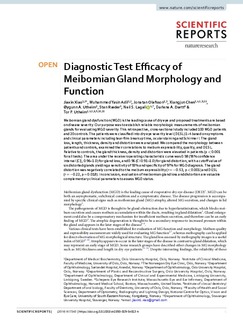| dc.contributor.author | Xiao, Jiaxin | |
| dc.contributor.author | Adil, Muhammed Yasin | |
| dc.contributor.author | Olafsson, Jonatan | |
| dc.contributor.author | Chen, Xiangjun | |
| dc.contributor.author | Utheim, Øygunn Aass | |
| dc.contributor.author | Ræder, Sten | |
| dc.contributor.author | Lagali, Neil | |
| dc.contributor.author | Dartt, Darlene Ann | |
| dc.contributor.author | Utheim, Tor Paaske | |
| dc.date.accessioned | 2020-01-28T13:48:55Z | |
| dc.date.available | 2020-01-28T13:48:55Z | |
| dc.date.created | 2020-01-16T12:58:53Z | |
| dc.date.issued | 2019 | |
| dc.identifier.citation | Scientific Reports. 2019, 9 (1). | nb_NO |
| dc.identifier.issn | 2045-2322 | |
| dc.identifier.uri | http://hdl.handle.net/11250/2638395 | |
| dc.description | Open Access This article is licensed under a Creative Commons Attribution 4.0 International License, which permits use, haring, adaptation, distribution and reproduction in any medium or format, as long as you give appropriate credit to the original author(s) and the source, provide a link to the Creative Commons license, and indicate if changes were made. The images or other third party material in this article are included in the article’s Creative Commons license, unless indicated otherwise in a credit line to the material. | nb_NO |
| dc.description.abstract | Meibomian gland dysfunction (MGD) is the leading cause of dry eye and proposed treatments are based on disease severity. Our purpose was to establish reliable morphologic measurements of meibomian glands for evaluating MGD severity. This retrospective, cross-sectional study included 100 MGD patients and 20 controls. The patients were classified into dry eye severity level (DESL) 1–4 based on symptoms and clinical parameters including tear-film breakup time, ocular staining and Schirmer I. The gland loss, length, thickness, density and distortion were analyzed. We compared the morphology between patients and controls; examined their correlations to meibum expressibility, quality, and DESL. Relative to controls, the gland thickness, density and distortion were elevated in patients (p < 0.001 for all tests). The area under the receiver operating characteristic curve was 0.98 (95% confidence interval [CI], 0.96–1.0) for gland loss, and 0.96 (CI 0.91–1.0) for gland distortion, with a cutoff value of six distorted glands yielding a sensitivity of 93% and specificity of 97% for MGD diagnosis. The gland distortion was negatively correlated to the meibum expressibility (r = −0.53; p < 0.001) and DESL (r = −0.22, p = 0.018). In conclusion, evaluation of meibomian gland loss and distortion are valuable complementary clinical parameters to assess MGD status. | nb_NO |
| dc.language.iso | eng | nb_NO |
| dc.rights | Navngivelse 4.0 Internasjonal | * |
| dc.rights.uri | http://creativecommons.org/licenses/by/4.0/deed.no | * |
| dc.title | Diagnostic Test Efficacy of Meibomian Gland Morphology and Function | nb_NO |
| dc.type | Journal article | nb_NO |
| dc.type | Peer reviewed | nb_NO |
| dc.description.version | publishedVersion | nb_NO |
| dc.rights.holder | © The Author(s) 2019 | nb_NO |
| dc.source.pagenumber | 8 | nb_NO |
| dc.source.volume | 9 | nb_NO |
| dc.source.journal | Scientific Reports | nb_NO |
| dc.source.issue | 1 | nb_NO |
| dc.identifier.doi | 10.1038/s41598-019-54013-4 | |
| dc.identifier.cristin | 1774783 | |
| cristin.unitcode | 222,56,2,0 | |
| cristin.unitname | Institutt for optometri, radiografi og lysdesign | |
| cristin.ispublished | true | |
| cristin.fulltext | original | |
| cristin.qualitycode | 1 | |

